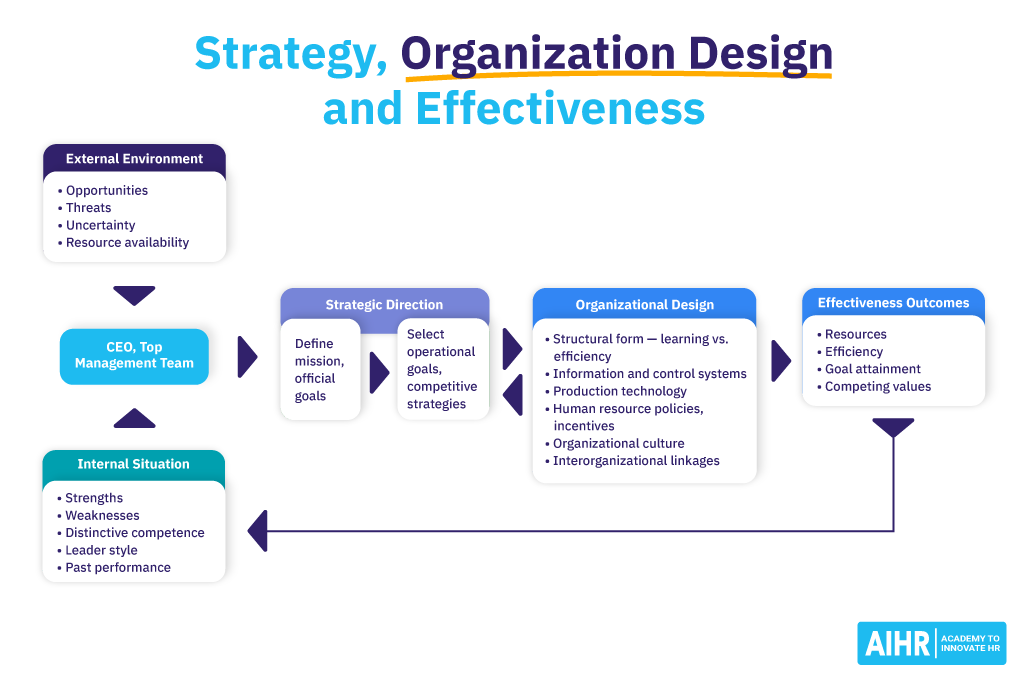Why Organizational Design Matters
In today’s fast-paced business landscape, organizational design is no longer a static framework—it’s a dynamic engine for innovation, efficiency, and adaptability.
Companies like Netflix and Spotify have thrived by embracing fluid structures that prioritize agility, while traditional giants like Blockbuster faltered due to rigid hierarchies.
But what separates thriving organizations from those that stagnate? The answer lies in aligning strategy, culture, and structure to create a cohesive system where people and processes work in harmony. In this guide, we’ll dissect the principles, drivers, and outcomes of effective organizational design, equipping you with actionable insights to future-proof your business.
What is Organizational Design?
Organizational design is the deliberate alignment of an organization’s structure, processes, and culture with its strategic objectives. It’s not just about org charts; it’s about creating ecosystems where employees collaborate seamlessly, decisions flow efficiently, and innovation thrives.
As illustrated in Figure 1 (Strategy, Organization Design, and Effectiveness), design is shaped by:
- Strategic Direction: Mission, vision, and competitive strategies.
- External Environment: Opportunities, threats, and resource availability.
- Internal Situation: Strengths, weaknesses, and leadership styles.
Example 1:
- Company A (Stable Market): Centralized authority, strict SOPs, and efficiency-driven processes. Think Walmart’s supply chain optimization.
- Company B (Innovation-First): Decentralized teams, flexible workflows, and reward systems for risk-taking. Example: Google’s “20% time” policy for side projects.
The Strategic Blueprint: Aligning Design with Business Goals
The CEO and top management play a pivotal role in setting the strategic direction. According to Harvard Business Review, 85% of leadership teams fail to execute strategies due to misaligned structures. Here’s how to bridge the gap:
- Define Clear Objectives: Translate mission statements into operational goals (e.g., “Increase market share by 15% in Asia-Pacific”).
- Choose Structural Form:
- Efficiency-Focused: Hierarchical layers, vertical communication (e.g., manufacturing firms).
- Learning-Focused: Flat structures, cross-functional teams (e.g., tech startups).
- Leverage Technology: Tools like Slack or Microsoft Teams enable real-time collaboration, reducing silos.
Five Organizational Design Principles (Goold & Campbell)
Balancing these principles is key to avoiding design pitfalls:
- Specialization Principle
- Test: Protect niche teams (e.g., R&D labs) from dominant cultures.
- Example: Apple’s secrecy-driven design team operates independently to foster innovation.
- Coordination Principle
- Test: Identify “difficult links” between departments. Use overlay units (e.g., Nike’s cross-functional product launch teams).
- Knowledge & Competence Principle
- Test: Delegate decisions to experts. Example: Zappos’ Holacracy model empowers frontline employees.
- Control & Commitment Principle
- Test: Balance oversight with autonomy. Avoid micromanagement—trust teams with budget decisions under $10K.
- Innovation & Adaptation Principle
- Test: Build flexibility. Adobe’s shift from perpetual licenses to a SaaS model (Creative Cloud) required redefining roles and KPIs.
Five Factors Shaping Organizational Design
- Strategy
- Porter’s Competitive Strategies dictate design. Example: A cost leadership strategy (e.g., IKEA) demands centralized procurement and standardized processes.
- Environment
- Assess stability using the Duncan Model (simple-complex vs. stable-unstable axes).
- Volatile Industries (e.g., fintech): Adopt agile frameworks like SAFe.
- Technology
- Size & Life Cycle
- Startups (organic, flat) vs. enterprises (mechanistic, layered). Use Greiner’s Growth Model to anticipate crises.
- Culture
- Apply the Competing Values Framework to align culture with design. Example: Netflix’s “Freedom & Responsibility” culture supports autonomous teams.
The Evolving Role of HR in Organizational Design
HR has transitioned from administrative support to a strategic partner. Key shifts:
- Data-Driven Design: Use employee surveys (e.g., Gallup Q12) to identify pain points.
- OD Centers of Excellence: Companies like Unilever have dedicated OD teams to align talent, rewards, and structure.
- Purpose-Driven Work: Redesign roles to emphasize meaning. Patagonia’s environmental mission drives its matrix structure.
Quote:
“Skipping the ‘as-is’ analysis is like building a house without a foundation. Data illuminates the path forward.”
— Dr. Dieter Veldsman, Chief HR Scientist, AIHR
Measuring Organizational Effectiveness
Three lenses to evaluate success:
- Resource-Based Approach: Track input efficiency (e.g., talent acquisition costs).
- Internal Process Approach: Monitor communication flow and decision speed (e.g., Spotify’s Squad Health Checks).
- Goal Approach: Measure output against KPIs (e.g., quarterly revenue growth).
Case Study: Coffee Bean Supply Chain Crisis
A global coffee producer missed sales targets due to delayed C-suite approvals for supply chain adjustments. By decentralizing procurement authority, decision latency dropped by 60%, aligning structure with environmental volatility.
Future-Proofing Your Design
- Embrace Hybrid Models: Blend remote and on-site work using tools like Asana.
- Invest in Upskilling: Platforms like Coursera prepare teams for AI-driven roles.
- Iterate Continuously: Adopt a test-and-learn mindset. Amazon’s “two-pizza teams” experiment with minimal bureaucracy.
Conclusion: Design for Tomorrow
Organizational design isn’t a one-time project—it’s a journey. By aligning strategy, culture, and structure, businesses can navigate disruption, attract top talent, and outperform competitors. Start small: Audit your current design, involve cross-functional stakeholders, and prioritize flexibility. As the Greek philosopher Heraclitus said, “Change is the only constant.” Design for it.
Further Reading:


